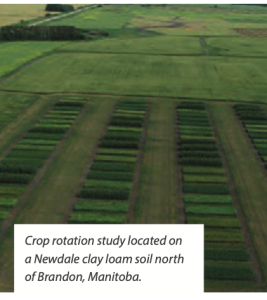Ramona Mohr, Research Scientist, AAFC – Brandon
Pulse Beat 96, Fall/Winter 2022
MANITOBA CROP ROTATIONS have changed significantly over the last 20 years. While the eastern prairies were once dominated by cereals and canola, Manitoba is now second only to Ontario in soybean production with roughly 1.1 million acres grown in 2022, a five-fold increase in seeded acreage compared to 15 years ago. With the availability of better-adapted varieties, soybeans have also made some inroads further west in recent years, with Saskatchewan soybean acreage peaking at 850,000 acres in 2017 before declining to 45,000 acres in 2022, and small amounts of soybeans also grown in Alberta. Although corn has not seen the same level of growth as soybeans, grain corn acreage in western Canada has roughly doubled over the last fifteen years, from 210,000 acres in 2007 to more than 414,000 acres in 2022, with more than 90% grown in Manitoba.
Diversifying rotations with corn and soybean is not a new idea for western Canada. In the early 1980s grain corn acreage in Manitoba was more than 200,000 acres, not reaching this level again until 2003. Soybean acreage also reached a peak of about 16,000 acres in south-central Manitoba in the early 1980s before declining. Although not successful then, better adapted varieties combined with a warming climate may provide new opportunities for expanded production in western Canada.
Establishing new crops in non-traditional growing areas is not without its challenges. Less than ideal growing conditions, agronomic and pest issues, and uncertainty about how best to fit these new crops into existing rotations can present production and economic risks. Although a significant amount of crop rotation research has been done across western Canada over the last century or more, relatively little information was available about corn and soybeans due to their limited acreages.
In 2018, a series of crop rotation experiments were initiated across western Canada to gain a better understanding of the risks and benefits of including soybeans and/ or corn in rotation with wheat and canola. As part of this project, seven rotations are being studied at each of Brandon, Indian Head, Saskatoon and Lethbridge: wheat-canola, soybean-corn, soybean-wheat-canola, corn-wheat-canola, corn-soybean-wheat, corn-soybean-canola, corn-soybean- wheat-canola. In this study, all crops are direct-seeded into stubble, and grown using best management practices. Soybeans are is seeded whereas corn is grown as a row crop.
Researchers from five AAFC research centres and three western Canadian universities are working together to investigate the effects of these rotations on yield and quality, disease, weed pressure, soil health, nutrient cycling, mycorrhizal colonization, profitability and economic risk, and to assess the weather-related risks and opportunities of growing corn and soybeans in western Canada. Effects of rotation length, the combination of crops grown in rotation, and the sequence of crops in rotation on agronomic and economic performance are being studied. One of the longer-term goals of this research will be to use data from this project, together with results from other crop rotation studies in western Canada, to develop a crop rotation economic calculator that will allow producers to compare current standard rotations with new and emerging rotation options.
The end of the 2022 growing season marked the first time since the crop rotation project started that all rotations have completed a full rotation cycle, and also the first year that soil quality will be assessed in each rotation. The aim over
he next few months will be to analyze the information collected so far to see how
the various rotations have performed to date. Preliminary results from the first few years of the study have shown occasional effects of preceding crops on yield and seed quality, but these effects have generally
been inconsistent across sites and years. Similarly, although root diseases have been detected, no strong trends related to rotation treatments have emerged at this point. These limited effects are not necessarily surprising in that changes in the plant-soil system related to rotation often tend to occur slowly over time as rotations mature.
Recent years of this study have also demonstrated some of the weather-related challenges of growing soybeans and corn in western Canada. Although the Brandon site has generally had adequate growing season moisture and timely rains, dry conditions in Saskatchewan significantly reduced soybean and corn yield potential at Indian Head
and Saskatoon in some years. In 2019, cold wet fall conditions combined with an early snowfall delayed corn and soybean harvest at some sites, while, at Saskatoon, the corn did not mature and no grain was harvested. The implications of these effects in terms of net revenue and economic risk at the various locations are being assessed.
The aim going forward is to try to continue these experiments for at least another five years in order to determine the longer-term performance of the various rotations. Because effects of rotation on the plant-soil system tend to accumulate over time, whether in the form of changes in soil quality, root disease pressure, or other factors that may affect crop productivity, rotations that provide the best economic returns in the short term may not necessarily be the most productive and sustainable in the longer term. Understanding how rotations perform and change over time, not only in terms of yield and economic returns, but also in terms of disease and weed pressure, soil quality, nutrient cycling, and other factors, will help to identify those rotations that reduce production risk and optimize economics over the longer term.

